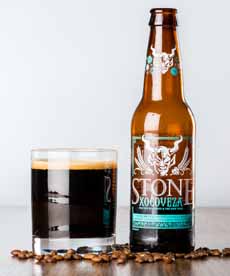TIP OF THE DAY: Coffee Stout & Other Styles For World Stout Day
|
|
November 5th is World Stout Say. Stout is the darkest and heartiest of beers (porter is in second place).
And if you like coffee too, we have a recipe for dessert: a coffee stout float. There are several categories of stout, a beer that has natural coffee and chocolate flavors from the types of malt used. It’s hard to pick one style from the list, so allow us to suggest a coffee stout. With the ascendancy of coffee as a craft drink in the U.S., combining it with stout is a natural. Beyond stout, coffee can be added to every style of beer. Here’s a list of the 18 “best” coffee beers from Gear Patrol, and 27 coffee beer recommentations from Thrillist. Stout is top fermented, which makes it an ale. Both stout and porter, its historic predecessor, are differentiated from conventional ale by their brown-black color, fuller body and stronger flavors. Stout originated in Ireland, where traditional stouts are very rich, yet sharp and slightly bitter. It followed the creation of porter, a strong, dark ale, higher in alcohol, that originated in London in the early 1720s. Large amounts of porter were subsequently exported to Ireland. By 1776, Arthur Guinness was brewing it at his St. James’s Gate Brewery in Dublin. Guinness Stout appeared by 1820. In the 19th century, porter evolved, creating the new category of stout, meaning strong. It was first called stout porter (stronger porter); later, the porter reference was dropped. Stout had a black color through the use of black patent malt and more roasted malts. It had a stronger in flavor than port. The alcohol level edged up, too. This is achieved by brewing with barley that has been dark-roasted to the point of charring (think of espresso beans, compared to a medium-roast coffee). It is thus both darker and maltier than porter, has a more pronounced hop aroma, and may reach an alcoholic content of 6% to 7%. While stout declined in popularity in the latter half of the 20th century, it has been resurrected by artisan brewers. A craft beer retailer should have a good selection. Stout pairs well with strong, spicy and salty flavors: |
|
|
For an easy dessert, whip up a coffee stout float with just two ingredients: stout and ice cream. If you can’t get coffee stout, use any cream/milk stout plus coffee ice cream. The recipe follows. Ingredients 1. PLACE two scoops of ice cream in a pint glass or other large glass. 2. Slowly pour the stout over the ice cream, to fill the glass. 3. SERVE with a straw and a spoon. ________________ *Although shellfish is not strong, spicy or salty, the pairing works—especially with Irish dry stout. Serve the shellfish simply.
|
||




